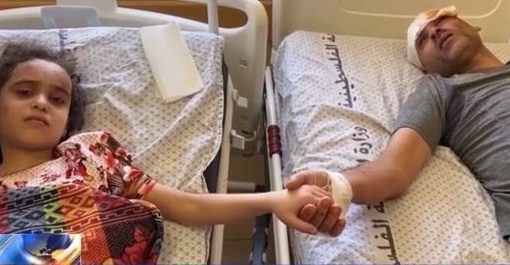Only two of the seven survived under the rubble of the Gaza girls
In the early hours of the 16th local time, a house in the Gaza Strip was destroyed in an Israeli air strike. Susie Eshkuntana, a 6-year-old girl living there, was rescued after being trapped under the rubble for seven hours, and her father survived, but her home was destroyed and her mother and several siblings were killed in the air strike.
Susie had been trapped under the rubble for seven hours when she was rescued, and was extremely weak. After being rescued, she was taken to the hospital where her father was located for treatment. Susie’s father, Riyad Eshkuntana, a family of seven, said he and his wife had arranged for their children to rest in rooms they thought were relatively safe before the air strike.
Riad Eshkuntana, resident of the Gaza Strip: “At the last moment before the explosion, we sat in the living room and put the children to sleep. We had three girls and two boys, and we put them to sleep in a room we thought was safe, and thought that if there was an air strike near the road, their room was far away.
However, air strikes soon occurred and quickly destroyed their houses.
Riad Eshkuntana, resident of the Gaza Strip: “I ran to see the girls, and my wife jumped up and hugged them and took them out of the room.” Then a second air strike hit the room, and I felt the ceiling destroyed and I was buried under the rubble. When my wife died, I saw her fall to the ground and the cement block hit her on the head, and we didn’t expect the ceiling and walls to fall.
Riyad Eshkuntana said he was trapped in the rubble and could only watch his loved ones die but could do nothing.
Riyad Eshkuntana, a resident of the Gaza Strip: “I was under the rubble, I was trapped, my hands were crushed by a pole, my legs were pressed by another pole, and I was in a terrible situation.” I heard my son Zayn shouting “Daddy, Dad” all the time, and his voice was still audible, but I was trapped and couldn’t turn around to see him, I had to call for help.
Forced re-conflict Palestinians were killed when their car hit a roadblock
The forced relocation of Palestinian residents in the Sheikh Jala area of East Jerusalem is the trigger for the current round of Israeli-Palestinian conflict, which has been the result of ongoing protests there. 16, a Palestinian driving into a roadblock in the Sheikh Jala area, the Palestinian was shot dead by Israeli police. Six Israeli police officers were also injured in the incident. Recently, Israeli courts planned to evict 28 Palestinian families living there and ask them to leave their homes, which they had lived in for many years, on the grounds that the Palestinian population in the Sheikh Jala area did not enjoy local land ownership.
Protests in the West Bank continued with the military throwing tear gas
Palestinians continue to protest in the Jewish settlement of Beit Elle in the West Bank on June 16. Protesters clashed with the Israeli military, which used drones to throw tear gas at protesters. According to Israeli media reports, the drone was able to drop six to 12 canisters of tear gas from the air. Last October, the Israeli Civil Administration’s High Planning Committee announced approval for more than 2,000 new homes in Jewish settlements in the West Bank. Subsequently, the Beit Elle settlement issued a statement saying that Israel would build 350 housing units in the area. The move sparked palestinian discontent and protests.
Experts commented on the continuing israeli-Palestinian conflict and the contradictions in the behavior of the United States
There has been a lot of intervention in the escalating Israeli-Palestinian conflict, but it has not yet been able to broker a ceasefire between the two sides. Yet America’s move is puzzling. On the one hand, obstructing the Security Council’s voice, on the other hand, U.S. President Joe Biden and Israeli and Palestinian leaders on the phone to discuss the ongoing conflict. So how do you see this series of operations in the United States? What is the intention of the United States behind the mediation? For related questions, listen to special commentator Su Xiaoxuan’s analysis



